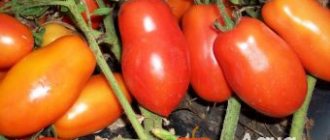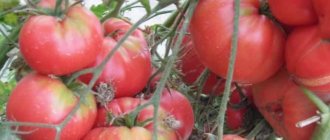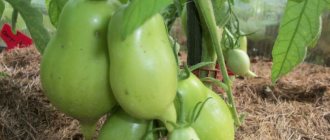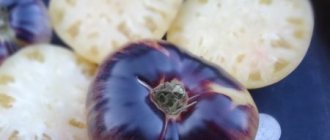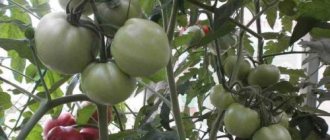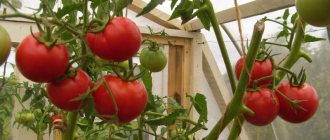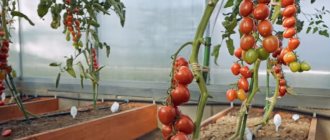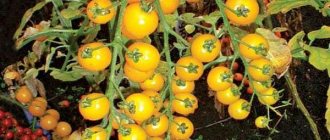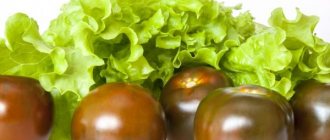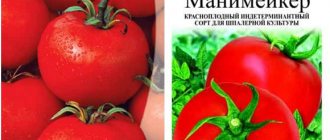When planting something new, you can always find such an interesting tomato as Honeydew. The variety bears fruit late in life, when most tomatoes have stopped ripening, and produces giant tomatoes. The juicy pulp has a sweetish taste with a hint of honey.
| Height | Landing location | Ripening time | Fruit color | Fruit size | Origin | Fruit shape |
| Medium height | Greenhouse, Open ground | Late ripening | Orange | Large | Variety | Flat-round |
Harvest
One and a half meter bushes bring a harvest of corresponding volumes above 115-120 days from the moment of planting the seeds.
One plant can do it. Ant. disassemble 5 kilograms of huge fruits, and 15 kilograms per square meter. You don’t have to worry about the new thing: there will be tomatoes even if the summer is completely cold. Thanks to its dense, non-cracking skin, Honeydews tolerate transportation infinitely well and are stored for a month and a half. This allows you to take them fresh even in November. They are very well suited for canning, which adds to their attractiveness among gardeners.
Honey dew is the fantasy of every summer resident. They are productive, unpretentious, tolerate transportation well, are stored for a long time, have excellent taste and are suitable for any purpose.
Characteristics of tomatoes of the Honeydew variety and their description
Fans of unusual varieties should definitely try the Honey Dew tomato. These tomatoes are not only beautiful in appearance, but also have a very pleasant taste. They are not suitable for canning, but those who like to eat salads from fresh vegetables will definitely like Honey Dew. The peculiarity of this variety is not only its interesting appearance, but also its unpretentiousness. Tomatoes tolerate cold summers well, so they can be planted in open ground even in the central and northern parts of the country.
Characteristics of tomatoes
The characteristics and description of the variety provide the following information. The tomato is determinate and grows no more than 1.5 m. Honeydew tomatoes are late-season tomatoes, so more than 4 months can pass from the moment the seeds are planted in the ground until the first fruits are received.
- The fruits are unusual. They are very large, and on average their weight reaches 400 g.
- The tomatoes turn out orange or creamy yellow.
- They are round.
- The skin density is high, so Honeydews are perfectly transportable.
- Ripe fruits can be stored for more than 1.5 months.
An important distinguishing characteristic of this variety is its taste. The pulp is dense and very sweet, even slightly with a hint of honey.
Planting and care
Honeydews are not a particularly fastidious variety. The tomato tolerates cold well and, if the basic growing rules are followed, produces an excellent harvest.
Seeds are planted 2 months before the intended planting in the ground
It is important that the seedlings germinate in warm conditions and conditions of sufficient humidity. In this case, the plant will become strong enough and will grow well in its permanent place.
Experts recommend using a growth stimulator for seedlings. Like all other varieties of tomatoes, it is recommended to gradually harden Honeydews, and not immediately plant them in the ground. 2 weeks are allotted for such an event.
Landing at a permanent place must be carried out according to the rules. Honeydew is a large bush, so no more than 3 plants can be planted per 1 m².
A prerequisite for proper growth and good yield is the removal of stepsons. Experienced gardeners recommend forming 1 bush from the plant.
Honeydew is a cold-resistant plant, so the variety will be an excellent option for those latitudes where summers are usually cold. And even with a lack of heat, where other varieties simply would not survive, Honeydews produce an excellent harvest.
Description and use
This variety is considered one of the most unpretentious, but the rules of watering and fertilization still need to be taken into account, otherwise there may not be a good yield.
If the gardener does everything right, large yellow tomatoes with an extraordinary taste await him. It is believed that up to 5 kg of tomatoes can be harvested from 1 bush. These are excellent results for an unpretentious plant that can bear fruit even in not the most favorable conditions.
Honeydews are a very large variety. Tomatoes are large, so they are not very suitable for canning as a whole. However, these tomatoes look great in salads and complement other components of the dish with their honeyed sweetness. Considering that this variety produces a large harvest, even from a small plot you can collect a large number of beautiful and tasty tomatoes, which will be enough for salads for the whole family, for juice, and for excellent adjika.
Excellent harvest in cold summers - Honey Dew tomato: detailed description of the variety
When planting something new, you can always find such an interesting tomato as Honeydew. The variety bears fruit late in life, when most tomatoes have stopped ripening, and produces giant tomatoes. The juicy pulp has a sweetish taste with a hint of honey.
| Height | Landing location | Ripening time | Fruit color | Fruit size | Origin | Fruit shape |
| Medium height | Greenhouse, Open ground | Late ripening | Orange | Large | Variety | Flat-round |
Description and characteristics of the variety
The Honey Dew tomato is a determinate, medium-growing variety. Features of the bushes:
- shoot height 1.2-1.5 m;
- powerful, strong stems;
- number of fruits 5-6 per cluster.
Description and characteristics of tomatoes:
- average weight 350-450 g;
- the pulp is sugary, fleshy;
- the skin is not cracking, durable;
- creamy yellow color;
- high level of carotenes and ascorbic acid.
Advantages and disadvantages
- large fruit;
- prolonged maturation;
- unpretentiousness of cultivation;
- endurance of adverse factors;
- disease and stress resistance;
- transportability.
Minuses:
- need for garter, feeding.
Productivity
From 1 m2 they collect 9-11 kg. Productivity is good.
Features of cultivation and storage
They are planted traditionally - using seedlings.
4 plants are placed per 1 m, the distance between holes is 50 cm.
How to grow correctly:
- guidance in 2 barrels;
- feeding during flowering, setting, ripening;
- spraying for prevention with Bordeaux mixture, “Fitosporin”;
- mulching with a layer of 8 cm.
Planting and care
How to make a substrate for seedlings:
- 2 parts garden turf;
- 1 part peat;
- 1 part ash;
- 1 part compost.
What conditions do seedlings need:
- temperature regime 20 degrees;
- watering with settled water;
- lighting with phytolamp.
Characteristics and description of the tomato variety Medovo sugar (Honey dew)
One of the main advantages of any cultivated plant is its resistance to unfavorable climatic conditions. Siberian breeders developed the Honey dew or Honey dew tomato. It bears fruit successfully even in cold summers.
General description of the variety
The plant is suitable for growing in greenhouse conditions and open ground. The choice depends on the climatic conditions of the region. Appearance and description of the variety:
- mid-ripening, fruit ripening time up to 115 days;
- medium-sized, maximum height of bushes 1.5 m;
- high yield, maximum weight of berries from one bush is 3 kg;
- the maximum number of brushes on one plant is 7 pieces;
- suitable for transportation and storage;
- determinate bushes;
- resistant to most pests and diseases;
- requires careful care.
Reviews from gardeners indicate the successful cultivation of the plant in different parts of the country. Good results were recorded even in the coldest regions: Siberia, Khabarovsk, Irkutsk, Magadan region. The popularity of the Honey Sugar variety of tomatoes is due not only to its endurance, but also to the taste of the fruit. Characteristics of ripe berries:
- round shape;
- color creamy yellow when ripe;
- smooth;
- medium size, maximum weight 300 grams;
- sweet, honey taste.
Tomatoes of the Honeydew variety are often included in children's and diet menus. To successfully grow tomatoes, you must first prepare them - grow seedlings.
Preparing seedlings and planting
To get a good harvest, it is better to plant tomatoes in seedlings. If you follow the recommendations, there will be no difficulties with the plant:
- preparatory work begins two months before the expected landing date;
- Seeds should be planted at a depth of 1.5-2 cm;
- Separate peat pots are suitable for seedlings;
- it is necessary to maintain the room temperature at least 23 degrees;
- to improve germination, it is recommended to use a growth stimulator;
- love abundant watering;
- growth requires a constant source of light.
It is recommended to harden off the seedlings a week before planting. Place the plants in fresh air, start the hardening time at 20 minutes and increase to at least 2 hours.
Important! When planting in the ground or greenhouse, do not place the seedlings close to each other. For 1 sq.
m there should not be more than three bushes.
The plant requires mandatory pinching. For best results, the bush should be formed into one stem.
Features of tomato care
Tomatoes require moderate attention. The rules of care include:
- watering with warm water at least once every five days;
- weeding, it is necessary to remove weeds;
- loosening;
- Feed the plant with mineral or complex fertilizer at least 4 times from the moment of planting.
Gardeners' opinion about the variety
I really liked the sweet tomatoes of the Honeydew variety. I grew it especially for a child, on the recommendations of a friend. My daughter eats it with pleasure - she has no allergies, I prepare salads and wrap them. The variety turned out to be not very whimsical in cultivation. The main thing is not to plant seedlings too close.
Tomatoes love space and good feeding. Over the summer I fertilized the bushes five times. In warm summers I harvest a good harvest, 4 kg per bush. A ripe tomato of a very beautiful honey color, regular shape, smooth. They withstand transportation well and can be stored for a long time. We eat our fresh tomatoes until the end of November.
I'm happy with the variety, I recommend it!
Valentina Karlovna, 35 years old.
I planned to make some beautiful preparations for winter. It took me a long time to choose the right tomatoes. According to the description, I liked the Honey Sugar tomatoes, the color and size are suitable for twists. The first harvest was harvested in August.
The ripe berries lived up to expectations. All of the correct shape, smooth, neat, the color is very beautiful - honey. Ripe tomatoes taste sweet with a slight sourness. I grew the variety in a greenhouse, there were no particular difficulties.
One of the features is mandatory stepsoning.
The bushes turned out to be tall, I tied them up. Everything else is the same as with other varieties - watering, loosening, feeding. The twists were a success; in the winter we will treat ourselves to pickles. Next year I plan to try planting the variety in open ground if the summer is warm. I will definitely share my impressions.
Ekaterina Maslyakova, 47 years old.
Honey Dew - variety of Tomato plant
Variety characteristics:
Properties of the Honey Dew variety:
Recommended region on the map:
Information on the admission of Tomato Honey Dew from the Register of the State Variety Commission of the Russian Federation
Application for admission No. 61662, registered 2013-10-23. The Honey Dew Tomato variety was included in the register of those approved in 2015. Approved for use in regions: All regions.
The originator of the Honey Dew Tomato variety is:
- AGROFIRM POISK LLC (140153, MOSCOW REGION, RAMENSKY DISTRICT, VEREYA DISTRICT, BUILDING 501)
Other varieties of tomato plant
Search for variety by name
Variety selection
Question to the portal experts
If you haven't found the answer to a question, don't hesitate to ask an expert.
Register or Login so you don't have to enter your Name and Email every time
Thanks for the comment! It will be published after checking by a moderator!
No comments yet, be the first!
A portal for those who love their dacha
Your question has been sent for moderation. Don't worry, we quickly check your questions and your question will be answered within 1 day.
We have noticed that you are already registered on our website. We recommend that you log in to view the question you created. If you don't remember your password, you can recover it.
You were not registered until today, so we have registered you. Your password has been sent to your specified mailbox.
Help our site develop!
Please read this message, it will not take up much of your time!
We so need your comments and questions to understand in which direction we should develop.
Don't forget to leave a comment if you found what you were looking for. And if you haven’t found it, use the “Ask an Expert” form in the site header. We will answer this question, and other visitors will be able to find the information that you could not find.
Sincerely, team of the portal Dacha-Dacha.ru
Your question has been sent for moderation. Don't worry, we quickly check your questions and your question will be answered within 1 day.
We have noticed that you are already registered on our website. We recommend that you log in to view the question you created. If you don't remember your password, you can recover it.
You were not registered until today, so we have registered you. Your password has been sent to your specified mailbox.
Tomato Honey Heart - description and characteristics of the variety
The recent development of breeders from Siberia - the Honey Heart tomato variety - will definitely be appreciated by gardeners who like to grow yellow tomatoes. Moreover, you don’t need to wait for the warm season at all - small bushes grow on the balcony in an attractive pot and give a good harvest.
Characteristics of the variety
Honey Heart is a first generation hybrid variety. The plant grows to a small height - no more than 70 centimeters, and sometimes less. The variety is early ripening. The first harvest can be harvested 90-95 days after the seedlings sprout.
The hybrid variety is characterized by high yield. From one square meter you can harvest about 8-8.5 kilograms of tomatoes. In the southern regions, the determinate type plant is successfully grown in open beds; in places with a temperate climate, cultivation in greenhouse conditions or in containers is recommended. Bushes should be formed into one stem.
The plant produces small, round fruits shaped like a heart. Tomatoes have smooth, non-pointed ends. The color of the skin and pulp of ripe tomatoes can range from pale yellow to a more intense orange-yellow. The weight of one fruit ranges from 120 to 140 grams.
The pulp of Honey Heart tomatoes contains many useful substances, which will appeal to those who adhere to proper nutrition or are on a diet. During the summer months, yellow tomatoes will be the main supplier of beta-carotene. In addition, the pulp of such fruits contains a large amount of sugars. Children love them very much for their sweet taste and bright color.
Tomatoes can be picked from the bush while they are not yet ripe - the fruits ripen well at home, accumulating the required amount of sugars. Honey Heart tomatoes have a fairly long shelf life; they are consumed fresh and used to prepare healthy tomato juice.
Advantages and disadvantages of the variety
Among the main positive qualities of the variety, gardeners highlight the following:
- Gives a large amount of harvest.
- The fruits have excellent taste characteristics.
- The pulp has a healthy composition, which contains a lot of beta-carotene and sugars.
- The plant is resistant to pests and major diseases that are typical for tomatoes.
- The variety is unpretentious in care - the bushes do not need to be pinched and shaped.
One of the negative qualities is that to grow the Honey Heart tomato, you need soil with high fertility.
Recommendations for cultivation
Since the Honey Heart variety is early ripening, the timing of planting seed for seedlings is quite extended. Seeds can be sown from early March to early April.
- Before planting seeds, it is necessary to treat them for the purpose of prevention against diseases and pests. To do this, you need to use a manganese solution. In addition, it is necessary to cultivate the soil in which the seeds will be planted. It is not recommended to lower the seed too deep into the ground; it is advisable to do this to a depth of one and a half centimeters.
- It is imperative to plant the seedlings when they reach a height of 5-7 centimeters and two leaves have formed on them. Sprouts will sprout faster if you fertilize it with fertilizers that contain potassium and magnesium.
- Seedlings should be transferred to open beds or a greenhouse from the second decade of May to the beginning of June. The soil must be fed with organic and mineral fertilizers. When planting, you need to ensure that the distance between the bushes is at least 40 centimeters.
- In summer, you should care for the plant in the same way as other varieties of tomatoes: loosen the soil, weed, remove weeds, and regularly water with warm water. The only difference is that stepsoning is not necessary.
Diseases and pests
To protect the plant from damage by diseases and pests, it is enough to pre-treat the seed. In unfavorable weather conditions (abnormally hot weather, prolonged cold snap), the plant is treated with phytosporin or another low-toxic fungicidal agent.
Gardeners' opinion
Most gardeners who have grown Honey Heart tomatoes on their plots speak extremely positively about this variety, noting its fairly high yield, low maintenance requirements, and excellent taste of the tomatoes.
Characteristics of the tomato Honey Fingers F1 and tips for breeding the hybrid
A small-fruited variety of yellow tomatoes, Honey Fingers F1, was bred by domestic breeders. It was included in the State Register of the Russian Federation relatively recently - in 2010. The hybrid tomato will decorate any area with bushes with clusters of golden fruits that are distinguished by excellent taste.
Description of the variety
Honey fingers tomatoes are a mid-season variety. Ripe fruits can be harvested in 90-110 days.
Among the characteristics that distinguish this species from other varieties of tomatoes, the size of the bush stands out. Since the plant belongs to the indeterminate type, its height can reach 2 m. Tomatoes of this variety must be tied to a support, the stepsons that have grown by 5-7 cm must be promptly removed, and the sprouts must also be pinched.
The characteristics and description of the variety in the state register include important information on growing this type of tomato. So, seed producers recommend planting 4 bushes per 1 m², forming it into 1 or 2 stems. If you decide to make a bush with 2 stems, you should leave 1 stepson that grew above the first brush, and remove all the others, including those located above, by pinching.
For large bushes it is very important to receive a sufficient amount of light, as well as the necessary nutrition in the form of various fertilizers. As a result of proper care, the yield from 1 m² can be up to 14 kg of tomatoes.
The Honey Fingers tomato has an elongated cylindrical shape. The size of the fruit is average, weight can range from 70 to 80 g. Ripe tomatoes may have faint orange stripes on the skin. These fruits are good for pickling and canning. Tomatoes of this variety are not suitable for ketchup and juice production.
When you cut the fruit, you can see the yellow, juicy pulp. A feature of yellow tomatoes is their high sugar content, which makes these fruits seem to taste like honey.
Tips for sowing seedlings and subsequent transplantation
Varieties with an average ripening period are planted from March 10 to March 20. Weather conditions typical for the region will tell you when it is best to sow the seeds.
Young tomatoes are transplanted into the main soil approximately 2 months after germination. They should form 5 to 7 true leaves. Honey Finger seedlings require moderate watering 1 or 2 times a week. Twice, simultaneously with watering, the plants are fed using liquid fertilizers specially designed for vegetable seedlings.
Hybrid tomatoes can grow outdoors in the southern regions of the country, and in the northern regions they are well accepted in greenhouses and under film covers.
Transplantation into the ground in the Middle Zone and Siberia occurs at the beginning of June. Plants can be transferred to areas covered with film in the middle or end of May. Young tomatoes can be planted in the greenhouse at the end of April.
During the first time after transplantation, young shoots need intensive watering and fertilizers.
So, ammonium nitrate or herbal infusion is applied for the first time 3 weeks after the plants have been transplanted to a permanent location. During this time, the bushes will already take root, and nutrition in the form of fertilizers will promote their growth. Further fertilizing with mineral fertilizers is carried out during periods when the tomato bush is blooming and also forms ovaries.
Features of growing in greenhouse conditions
Those who have never planted tomatoes in a greenhouse should take note of the following recommendations:
- A week before the tomato bushes bloom, install a large-volume vessel (up to 100 liters) in the greenhouse. You need to put herbs in it (about half) and fill it with water. During the fermentation process, gas formation will begin, which will have a positive effect on the pollination process and the preservation of ovaries and flowers.
- Watering plants should occur in the morning; it is especially important to take this regime into account in the second half of summer, which is characterized by a decrease in night temperatures. Such an irrigation system will prevent condensation from forming in the greenhouse, which will protect tomato plants from diseases such as late blight or blossom end rot.
- Dry grass in a layer of 8 or 10 cm laid on top of the ground will protect against excess heat and retain moisture in the soil.
- From the first days of July, the lower leaves are removed from the bushes. This will take the load off the bush.
Reviews from summer residents and vegetable growers contain many positive characteristics of the Honey Fingers variety; many gardeners strongly recommend growing yellow tomatoes.
moefermerstvo.ru
Agricultural nursery "Vishnyakovsky"
The prices at the Vishnyakovsky agro-nursery were a pleasant surprise. My first and only order from them was quite large: a white park rose, three bushes of hybrid tea roses of different varieties, a Floribunda rose bush, 9 sections of phlox of different varieties, 4 rhizomes of dahlias of different varieties, corms of various gladioli. My order was sent in a timely manner in the spring, one of the first. All purchased planting material took root well in the garden and began to actively grow.
But here’s the problem with this order: all the numerous pieces of phlox sent to me by the Vishnyakovites, and all the dahlia rhizomes turned out to be not of different varieties, as was ordered, but of one variety and one color - pink! Otherwise, everything was not bad - these phloxes and dahlias bloomed wonderfully along with a variety of roses and gladioli.
However, Vishnyakovsky roses did not survive the severe frosts of the winter of 2005-2006. And the roses I bought from agro, covered for the winter in the same way, all survived!
Characteristics
King of Kings is one of the newest hybrids, incorporating the best qualities of many time-tested and modern varieties.
The advantages of a hybrid include:
- high productivity;
- large, beautiful fruits;
- wonderful taste;
- good transportability;
- resistance to late blight;
- good keeping quality of the crop.
There are very few reviews about growing these tomatoes, so the only disadvantages noted are:
- high price of seeds;
- impossibility of use for preservation and pickling.
What are tomato fruits?
- This is a giant variety.
- The color of the tomato is bright red.
- Their surface is slightly ribbed, smooth, their shape is round, slightly flattened.
- The pulp is dense, fleshy, not too juicy.
- Each tomato has 4 to 8 seed chambers and thick, fleshy septa.
- The dry matter content of fruits is 8-10%.
- The taste is pleasant, sweet, with a slight sourness.
- The fruits have high commercial quality and good transportability.
- Tomatoes are large in size. The average weight of one tomato ranges from 1000 to 1500 g. Minimum weight – 200 g.
- Grows 5 pieces from one brush.
King is a table variety. Perfect for making salads, can be processed into juices, pastes, and purees. Not used for canning or pickling.
On our website you will find a lot of useful information about growing tomatoes. Read all about indeterminate and determinate varieties.
And also about the intricacies of caring for early ripening varieties and varieties characterized by high productivity and disease resistance.
You can compare the weight of the fruits of this variety with others in the table below:
| Variety name | Fetal weight |
| King of Kings | 200-1500 |
| Bella Rosa | 180-220 |
| Gulliver | 200-800 |
| Pink Lady | 230-280 |
| Andromeda | 70-300 |
| Broody | 90-150 |
| Brawler | 100-180 |
| Grapefruit | 600 |
| De Barao | 70-90 |
| De Barao the Giant | 350 |
Honey variety tomatoes on video
If you grew Honey tomatoes, please write whether you liked them or not. What was the yield and taste of the fruit under your conditions? How do you rate the disease resistance of this variety? If possible, attach a photo of the entire bush or individual fruits you grew to your comment. Thank you!
Your reviews of the Honey tomato and additions to the description will help many gardeners evaluate this variety more objectively and decide whether it is worth planting or not.
This is a natural variety of tomato. Therefore, we recommend taking seeds from a ripe fruit and using them for planting in subsequent seasons.
Planting in the ground and caring for plants
Landing does not require any special effort. You just need to remove the stepsons, cut out the lower leaves and form the bushes into one stem. It is necessary to plant plants at the rate of 3 bushes per square meter. Caring for them is quite simple. You just need to water, weed, loosen, tie up and feed. With all this, a garter is especially necessary, because along with this, up to 5 kilograms of fruit can fit on the bushes. In the same way, (reinforced) is needed, since without it, plants begin to lose their immunity to various diseases.
Honeydews rarely get sick. To prevent the disease from overtaking the tomato, it is necessary to caress it properly and feed it on time.
Preparing seedlings and planting
To get a good harvest, it is better to plant tomatoes in seedlings. If you follow the recommendations, there will be no difficulties with the plant:
- preparatory work begins two months before the expected landing date;
- Seeds should be planted at a depth of 1.5-2 cm;
- Separate peat pots are suitable for seedlings;
- it is necessary to maintain the room temperature at least 23 degrees;
- to improve germination, it is recommended to use a growth stimulator;
- love abundant watering;
- growth requires a constant source of light.
It is recommended to harden off the seedlings a week before planting. Place the plants in fresh air, start the hardening time at 20 minutes and increase to at least 2 hours.
Important! When planting in the ground or greenhouse, do not place the seedlings close to each other. For 1 sq. m there should not be more than three bushes.
The plant requires mandatory pinching. For best results, the bush should be formed into one stem.
Description of the tomato variety Pink Honey
The variety is mid-season; tomatoes need 110-115 days to fully ripen. The bushes are of a determinate type, growing 60-100 cm high. There are not many leaves, they are medium in size, dark green in color. Inflorescences of a simple type. The fruits ripen in clusters. If the fruits are large, then there will be no more than 3 of them in a bunch, if small - up to 10 pieces.
The fruits grow weighing about 700 g
The fruits grow weighing 700 g, but the very first specimens can reach 1.5 kg. They are shaped like a heart, the ribs are almost indistinguishable. The skin is thin, of moderate density. The color is pink when fully ripe. The flesh is also pink, but darker than the skin. It is meaty, with a high juice content. The taste is sweet, without sourness.
Characteristics
The “Honey” tomato variety was bred by our Siberian specialists specifically for harsh growing conditions. It received state registration as a variety recommended for greenhouses and open ground in 2004. Since then, it has enjoyed steady popularity among hobbyists and farmers.
In greenhouse conditions, tomatoes of this type can be grown in almost any region of Russia. In open ground it gives good results in southern and middle climatic zones. The Honey tomato variety differs from many others in its stability and unpretentiousness.
What are the nutritional characteristics of the Honey tomato? Ripe fruits are very good fresh. They are practically not used in whole-fruit canning due to their large fruit size. Can be used in barrel pickles. This variety of tomatoes produces excellent juice due to the unique combination of acids and sugars.
"Honey" has a fairly good yield. With proper care, you can get up to 3.5-4 kg from one bush. With the recommended planting scheme of 3-4 bushes, it turns out 14-16 kg, which is a very good indicator.
You can compare the yield of this variety with others in the table:
| Variety name | Productivity |
| Honey | 14-16 kg per square meter |
| Baron | 6-8 kg per bush |
| Apples in the snow | 2.5 kg per bush |
| Tanya | 4.5-5 kg per square meter |
| Tsar Peter | 2.5 kg per bush |
| La la fa | 20 kg per square meter |
| Nikola | 8 kg per square meter |
| Honey-sugar | 2.5-3 kg per bush |
| King of Beauty | 5.5-7 kg per bush |
| King of Siberia | 12-15 kg per square meter |
Productivity of the variety
We recommend reading our other articles
- Drip irrigation system
- Proper care of cucumbers in a greenhouse
- Wild bees
- Why do ficus leaves fall off?
The yield of Honey tomato is on average up to 15 kg of fruit from each square of plantings. But, if the plants are not fed or watered properly, it will drop to 8-10 kg. On average, up to 3.5 kg of tomatoes are harvested from one bush per year.
Interesting!
The taste of a tomato is mainly determined by elements such as boron, magnesium, molybdenum, calcium and sulfur. If the fruits have enough of them, the taste will be rich and sweetish.
The harvest is suitable for making juice and sauce. The fruits make delicious summer salads and fresh snacks.
General description of the variety
The plant is suitable for growing in greenhouse conditions and open ground. The choice depends on the climatic conditions of the region. Appearance and description of the variety:
- mid-ripening, fruit ripening time up to 115 days;
- medium-sized, maximum height of bushes 1.5 m;
- high yield, maximum weight of berries from one bush is 3 kg;
- the maximum number of brushes on one plant is 7 pieces;
- suitable for transportation and storage;
- determinate bushes;
- resistant to most pests and diseases;
- requires careful care.
Reviews from gardeners indicate the successful cultivation of the plant in different parts of the country. Good results were recorded even in the coldest regions: Siberia, Khabarovsk, Irkutsk, Magadan region. The popularity of the Honey Sugar variety of tomatoes is due not only to its endurance, but also to the taste of the fruit. Characteristics of ripe berries:
- round shape;
- color creamy yellow when ripe;
- smooth;
- medium size, maximum weight 300 grams;
- sweet, honey taste.
Tomatoes of the Honeydew variety are often included in children's and diet menus. To successfully grow tomatoes, you must first prepare them - grow seedlings.
| Variety: | mid-season |
| Determinacy: | indeterminate |
| Sowing seedlings: | March |
| Transplanting into the ground: | May |
| Harvesting: | August, July |
| Soil type: | closed |
| Fetal weight: | 450 g |
| Suitable for preservation: | Yes |
| Packing: | 10 pieces |
Delicate sweet Deeply orange salad tomato with outstanding taste. Mid-late variety for film greenhouses. The plant is tall and requires shaping and staking. The fruits are round or slightly flat-round in shape, weighing up to 450 g. Very tasty, bright, fleshy. The unique orange color of the pulp is highly valued for making soups and sauces. Fruit formation stimulator TOMATON is a guarantee of high yield under any unfavorable growth conditions
The Honey tomato is a mid-season variety. The first fruits need 110-115 days to fully ripen. The bush is indeterminate, tall, and requires staking to a trellis or stakes. The leaves are large and dark green in color. Inflorescences of a simple type.
Honey tomato fruits grow weighing 300-400 g. The taste is sweetish with a honey aftertaste.
Important!
Sweet tomatoes can only grow if they get plenty of sunlight.
Therefore, it is necessary to plant plants not densely, but it is important to remove all excess stepsons and leaves in time
The fruits are round, flattened at the top and bottom. The variety is characterized by large ribbing. After full ripening, the peel acquires a bright pink color. The fruits grow weighing 300-400 g. The pulp is multi-chambered, fleshy, with a lot of juice. Not a lot of seeds. The taste is sweetish, with a honey aftertaste, which is where the name comes from.
The Honey variety tomato is in great demand among gardeners. It is not difficult to grow and the fruits are very tasty.
- Lyudmila Gribko: “Even though the variety is called Honey, my harvest was not distinguished by its sweetness, but perhaps it’s due to the lack of sun, I don’t know. Caring for the bushes was not difficult. I treated it a couple of times with fungicides and carried out regular fertilizing with minerals. The tomatoes grew large and rich in color. Just what you need for salads. And yet it’s a pity, they are not as sweet as I would like, I expected more!”
- Andrey Koroza: “Not a bad variety. The tomatoes grow beautifully, the flesh is almost red, very juicy. Almost the entire harvest was processed into juice. The family is very happy. Plants are not demanding in terms of care. Even if I forgot to water, they grew without problems. The fruits turned out sweet, very tasty, at least sell them! Next year they will definitely plant them again.”
- Tatyana Davydova: “I used to always grow these tomatoes in open ground. This time I tried to make them in a greenhouse - it turned out that it was even easier to grow this way. The harvest was 1.5 times more. The fruits are very sweet, rich in color, half were sold, the other was put into canning. I’m very pleased with the variety; now they will grow it every year in greenhouses!”
We invite you to familiarize yourself with: Profiled sheet characteristics and dimensions
Features of cultivation
Tomatoes require moderate attention. The rules of care include:
- watering with warm water at least once every five days;
- weeding, it is necessary to remove weeds;
- loosening;
- Feed the plant with mineral or complex fertilizer at least 4 times from the moment of planting.
To ensure a good harvest, it is recommended to grow tomatoes in seedlings. Preparation of seeds for sowing begins 2 months before the expected date of transfer to the ground to a permanent place.
For seedlings, you can use containers or separate peat pots. Seeds are planted at a depth of 1.5-2 cm. To increase the germination rate, it is recommended to use a growth stimulator.
The formation of healthy planting material requires a constant source of light, an air temperature of 23 ° C and abundant watering, which is best done by drip using a sprinkler.
When planting in the ground, seedlings are placed at a distance from each other, based on 3 bushes per 1 m². The plant requires the removal of excess shoots and foliage. To increase the yield, it is recommended to form bushes with 1 stem.
Bushes of the Honey Dew variety reach a height of 0.8-1.5 m and require additional support. Under good conditions, up to 7 clusters can be formed on the plant.
The crop requires additional fertilizing with complex or mineral fertilizers according to the manufacturer’s scheme. Watering the plant should be carried out systematically, with warm water, at least once every 5 days.
The Honey tomato variety grows well both indoors and outdoors. And yet, experts recommend growing it outdoors only in the southern regions, where summers are long and warm. In the middle zone, you should give preference to greenhouse cultivation to get a really sweet harvest.
These tomatoes are usually grown using the seedling method. Seedlings are done on average 2 months before the day of transplantation to a permanent place. At the 2-leaf stage, the sprouts are picked into separate cups. When the seedlings are already strong enough, they are transplanted into the ground. There are 3-4 sprouts per square meter.
- A bush with 2 stems is formed. To get 2 trunks, you need to leave a side shoot - a stepson, which will appear under the first flower cluster. Pruning is carried out regularly, otherwise the crop may take a long time to ripen.
- It is highly recommended to tie tomatoes with some non-natural material. If you use natural materials, such as cotton fabric, the stem may begin to rot.
- During fruit ripening, it is important to water infrequently.
Of course, a lot of moisture causes tomatoes to grow large, but this can reduce the concentration of sugars and nutrients. And at the end of fruit ripening, watering is stopped altogether. The bush is indeterminate, tall, requires staking - After watering, if the soil becomes crusty, it is worth loosening it. Hilling is also necessary; it is done approximately 3-4 times per season. Thus, the growth of the root system improves, the crop becomes strong and less susceptible to pests and diseases.
- Fertilizing is applied throughout the entire period of fruit ripening. In the summer, in order for the tomatoes to ripen sweet, it is important to add potassium-phosphorus substances. For example, Monophosphate is diluted in an amount of 1 tsp. per 10 liters of water and spray 5 plants with this amount. From organic matter, we can recommend an infusion of ash (100 g per 10 liters of boiling water). After a day of infusion, the liquid is used for irrigation. 0.5 liters are consumed per plant.
Interesting!
To prevent late blight, healthy plants need to be sprayed with garlic infusion. The solution is made from 100 g of garlic and a glass of water. When the infusion has stood for 24 hours, it is mixed with 10 liters of water and the bushes are sprayed every 1.5-2 weeks.
- Honey tomato can get sick, like other types of tomatoes.
But if desired, you can reduce the incidence to a minimum. To do this, 2-3 sprayings with fungicides and insecticides are carried out every season. Such treatments are preventive in nature, so complex-action drugs are used. For prevention, you can also use folk infusions and solutions. Honey tomato yield averages up to 15 kg per square
Honey saved from these seeds in my garden, photo
My bush grew over 1 m and was not indeterminate. I would call him medium-sized. I agree with the high yield. The bushes, indeed, bore fruit abundantly and were hung with 150-200 g of fruits.
Last season, Honey Spas was one of the most productive varieties in my garden.
Elongated tomatoes. Immature ones have dark green shoulders.
My Honey Spas – there are dark green shoulders, the shape of the fruit is elongated
The abundance of fruits on the bushes was very pleasing to the soul. They did not get smaller; they were all the same size in the brush.
As the tomatoes ripened, they turned bright yellow.
Honey Spas tomatoes are ripe
But tomatoes of this variety were cracking in my garden, plus I picked a few and threw them away due to blossom end rot.
Other varieties did not have it.
As for the taste, the inside is solid pulp, there are very few seeds.
Tomato Honey saved in a section
The tomatoes were juicy and melted in your mouth, but despite their promising appearance, they were a bit sour. And the sourness clearly prevailed over the sweetness. The summer was hot, the sun was enough to increase sugar levels. Perhaps I will save my Honey because I didn’t give him some microelements.
